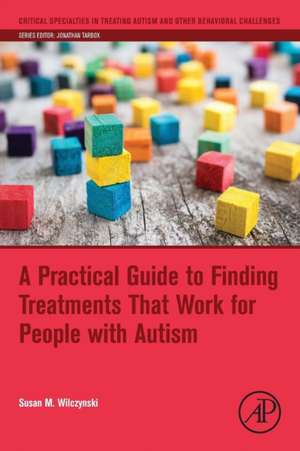A Practical Guide to Finding Treatments That Work for People with Autism: Critical Specialties in Treating Autism and other Behavioral Challenges
Autor Susan M. Wilczynskien Limba Engleză Paperback – 5 ian 2017
By providing multiple illustrative examples, practitioners will learn to use their professional judgment to integrate the best available evidence with client values and context. This will increase the efficacy of autism treatments, with the goal of producing meaningful gains across a range of skills.
- Presents a detailed description of the evidence-based practice of applied behavior analysis as it applies to ASD
- Offers a decision-making framework that helps clinicians integrate the best available evidence with client values and context
- Guides practitioners through the process of assessing treatment outcomes that fit with client values and contextual variables
- Provides concrete examples for various age groups
Preț: 205.46 lei
Nou
Puncte Express: 308
Preț estimativ în valută:
39.31€ • 41.16$ • 32.53£
39.31€ • 41.16$ • 32.53£
Carte tipărită la comandă
Livrare economică 29 martie-12 aprilie
Preluare comenzi: 021 569.72.76
Specificații
ISBN-13: 9780128094808
ISBN-10: 012809480X
Pagini: 138
Dimensiuni: 152 x 229 x 13 mm
Greutate: 0.23 kg
Editura: ELSEVIER SCIENCE
Seria Critical Specialties in Treating Autism and other Behavioral Challenges
ISBN-10: 012809480X
Pagini: 138
Dimensiuni: 152 x 229 x 13 mm
Greutate: 0.23 kg
Editura: ELSEVIER SCIENCE
Seria Critical Specialties in Treating Autism and other Behavioral Challenges
Cuprins
Section I: Evidence-Based Practice: A Brief Overview
Section II: Best Available Evidence
1. Systematic Review
2. Other Sources of Evidence
Section III: Target, Stakeholder, and Leader Client Variables, Values, and Preferences
3. Client Health
4. Client Repertoire and Behavioral Cusps
5. Client Preferences
6. Quality of Life, Generalization, and Social Validity
7. Treatment Acceptability and Social Validity
8. Treatment Feasibility and Social Validity
9. Context Matters: Getting Systems to Adopt Treatments
Section IV: Professional Judgment
10. Initial Selection: Weighing and Integrating Information
11. Progress Monitoring
12. Determining the Next Step
Section V. Conclusions and Examples
Section II: Best Available Evidence
1. Systematic Review
2. Other Sources of Evidence
Section III: Target, Stakeholder, and Leader Client Variables, Values, and Preferences
3. Client Health
4. Client Repertoire and Behavioral Cusps
5. Client Preferences
6. Quality of Life, Generalization, and Social Validity
7. Treatment Acceptability and Social Validity
8. Treatment Feasibility and Social Validity
9. Context Matters: Getting Systems to Adopt Treatments
Section IV: Professional Judgment
10. Initial Selection: Weighing and Integrating Information
11. Progress Monitoring
12. Determining the Next Step
Section V. Conclusions and Examples








